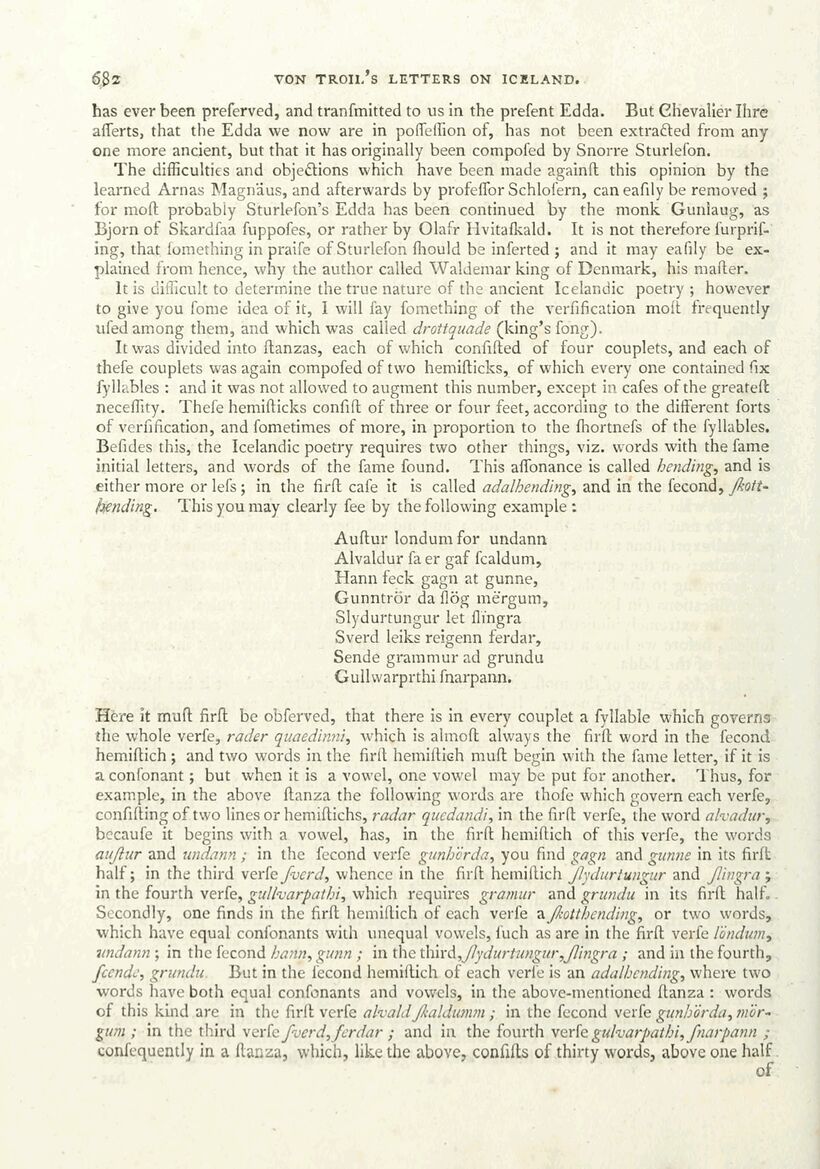
Full resolution (JPEG) - On this page / på denna sida - Pages ...

<< prev. page << föreg. sida << >> nästa sida >> next page >>
Below is the raw OCR text
from the above scanned image.
Do you see an error? Proofread the page now!
Här nedan syns maskintolkade texten från faksimilbilden ovan.
Ser du något fel? Korrekturläs sidan nu!
This page has never been proofread. / Denna sida har aldrig korrekturlästs.
682 VON TROIL’S LETTERS ON ICELAND.
has ever been preferved, and tranfmitted to usin the prefent Edda. But Chevalier Thre
afferts, that the Edda we now are in poffeflion of, has not been extracted from any
one more ancient, but that it has originally been compofed by Snorre Sturlefon.
The difficulties and objections which have been made againft this opinion by the
learned Arnas Magnius, and afterwards by profeffor Schlofern, can eafily be removed ;
for moft probably Sturlefon’s Edda has been continued by the monk Guniaug, as
Bjorn of Skardfaa fuppofes, or rather by Olafr Hvitafkald. It is not therefore furprif-
ing, that fomething in praife of Sturlefon fhould be inferted ; and it may eafily be ex-
plained from hence, why the author called Waldemar king of Denmark, his maiter.
It is difficult to determine the true nature of the ancient Icelandic poetry ; however
to give you fome idea of it, 1 will fay fomething of the verfification moft frequently
ufed among them, and which was called drottqguade (king’s fong).
It was divided into ftanzas, each of which confifted of four couplets, and each of
thefe couplets was again compofed of two hemifticks, of which every one contained fix
fyllables : and it was not allowed to augment this number, except in cafes of the greateft
neceflity. Thefe hemifticks confift of three or four feet, according to the different forts
of verfification, and fometimes of more, in proportion to the fhortnefs of the fyllables.
Befides this, the Icelandic poetry requires two other things, viz. words with the fame
initial letters, and words of the fame found. This affonance is called bending, and is
either more or lefs; in the firft cafe it is called adalhending, and in the fecond, /hott-
fending. ‘This youmay clearly fee by the following example :
Autftur londum for undann
Alvaldur fa er gaf fcaldum,
Hann feck gagn at gunne,
Gunntror da fl6g mérgum,
Slydurtungur let flingra
Sverd leiks reigenn ferdar,
Sende grammur ad grundu
Gullwarprthi fnarpann,
Here it muft firft be obferved, that there is in every couplet a fyllable which governs
the whole verfe, rader quaedinni, which is almoft always the firft word in the fecond
hemiftich ; and two words in the firft hemiftich muft begin with the fame letter, if it is
aconfonant ; but when it is a vowel, one vowel may be put for another. ‘Thus, for
example, in the above ftanza the following words are thofe which govern each verfe,
confifting of two lines or hemiftichs, radar quedandi, in the firft verfe, the word alvadur,
becaufe it begins with a vowel, has, in the firft hemiftich of this verfe, the words
auftur and undann ; in the fecond verfe gunherda, you find gagn and gunne in its firlt
half; in the third verfe /verd, whence in the firft hemiftich //ydurtungur and /lingra 3
in the fourth verfe, gu//varpathi, which requires gramur and grundu in its firft half. .
Secondly, one finds in the firft hemiftich of each verfe a /hotthending, or two words,
which have equal confonants with unequal vowels, fuch as are in the firft verfe /éndum,
undann ; in the fecond hann, gunn ; in the third, /ydurtungur, flingra ; and in the fourth,
feende, grundu. But in the fecond hemittich of each verte is an adalhending, where two
words have both equal confonants and vowels, in the above-mentioned ftanza : words
of this kind are in the firft verfe alvald fhaldumm ; in the fecond verfe gunhérda, mér-
gum ; in the third verfe /verd, ferdar ; and in the fourth verfe gulvarpathi, fnarpann ;
confequently in a ftanza, which, like the above, confifts of thirty words, above one he
19)
<< prev. page << föreg. sida << >> nästa sida >> next page >>